Superfluidity of p-wave and s-wave atomic Fermi gases in optical lattices
- 格式:pdf
- 大小:785.70 KB
- 文档页数:17
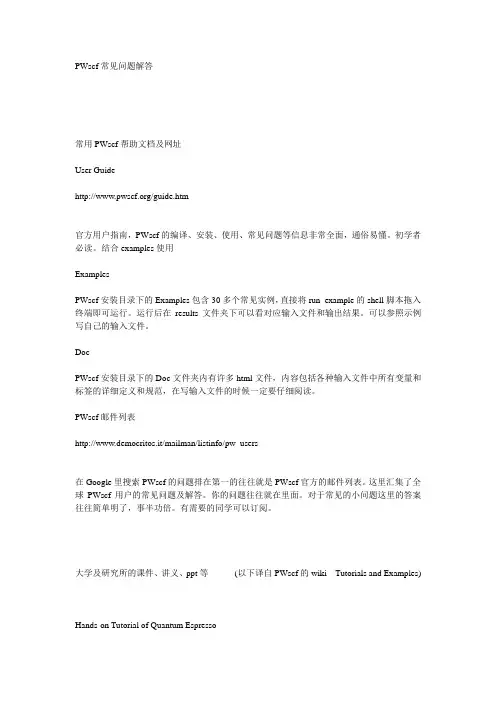
PWscf常见问题解答常用PWscf帮助文档及网址User Guide/guide.htm官方用户指南,PWscf的编译、安装、使用、常见问题等信息非常全面,通俗易懂。
初学者必读。
结合examples使用ExamplesPWscf安装目录下的Examples包含30多个常见实例,直接将run_example的shell脚本拖入终端即可运行。
运行后在results文件夹下可以看对应输入文件和输出结果。
可以参照示例写自己的输入文件。
DocPWscf安装目录下的Doc文件夹内有许多html文件,内容包括各种输入文件中所有变量和标签的详细定义和规范,在写输入文件的时候一定要仔细阅读。
PWscf邮件列表http://www.democritos.it/mailman/listinfo/pw_users在Google里搜索PWscf的问题排在第一的往往就是PWscf官方的邮件列表。
这里汇集了全球PWscf用户的常见问题及解答。
你的问题往往就在里面。
对于常见的小问题这里的答案往往简单明了,事半功倍。
有需要的同学可以订阅。
大学及研究所的课件、讲义、ppt等(以下译自PWscf的wiki Tutorials and Examples) Hands-on Tutorial of Quantum Espresso关于理论背景和计算实例的一些pptSchool on Electronic Structure Calculations and their applications in Materials Science, 25 April-6 May 2005,伊朗某大学关于计算材料学的课程的一些lectures3.320 Atomistic Modeling of Materials,MIT的课件MSE791K Modeling from the nanoscale to the macroscale,北卡州立大学的课件Quantum Espresso Survival GuideLecture videosUIUC计算材料中心2006年夏令营的课件和视频Building Nanostructures Bit by Bit康奈尔大学纳米科技中心2006年秋季研讨会的讲座和指南,包括平面波赝势法、密度泛函理论、分子动力学、纳米光学等方面的资料VLab Lectures密度泛函理论和实例如何安装编译PWscf?单机安装简易版(适用Ubuntu32位操作系统)from Sunforever首先安装编译环境,确认联网并更新了软件源,在终端下输入:sudo apt-get install gfortransudo apt-get install mpich-bin然后去PWscf网站下载免费的源码包www.pwscf .org解压到任意目录在终端窗口进入解压目录,方法如下:输入:cd 路径(可直接把文件夹拖拽进终端自动生成路径)然后输入./configure等屏幕上一堆字刷完再输入make all继续等刷屏大概十分钟以后应该就好了测试软件进入解压目录下的examples文件夹看到有很多example01 example02等目录随便进一个把run_example文件拖进终端窗口看运行是否正常也可以运行examples文件夹下的run_all_examples文件运行所有的示例计算结果在各自文件夹下的results目录里要清除计算结果运行examples下的make clean文件本教程应该适用于32位Ubuntu为基础的所有衍生版64位Ubuntu源里好像没有mpich,需要自己下源码编译一个台湾人写的安装教程(适用于Ubuntu8.10)转自Hialan 的嘴砲天地pwscf - ubuntu 8.10 安裝筆記前幾天應數所的學弟玩Linux 碰到問題,原來是不會裝這個...PWscf 是用來做工程及科學計算的,PWscf 的介紹如下,總之先幫他裝起來吧!PWscf 首頁上的介紹:PWscf (Plane-Wave Self-Consistent Field) is a computer code for electronic-structure calculations within Density-Functional Theory and Density-Functional Perturbation Theory, using pseudopotentials and a plane-wave basis set. PWscf is part of the Quantum ESPRESSOthe atomic scale. PWscf is released under the GNU General Public License. distribution of codes for the quantum simulation of matter at因為學弟的電腦是Ubuntu 8.10 ,我也不知道在其他distribution 可不可以依照相同的步驟安裝;這裡列出一些套件,找相對應的裝應該就差不多了吧。
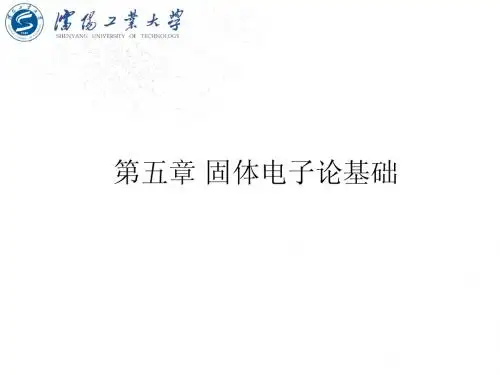
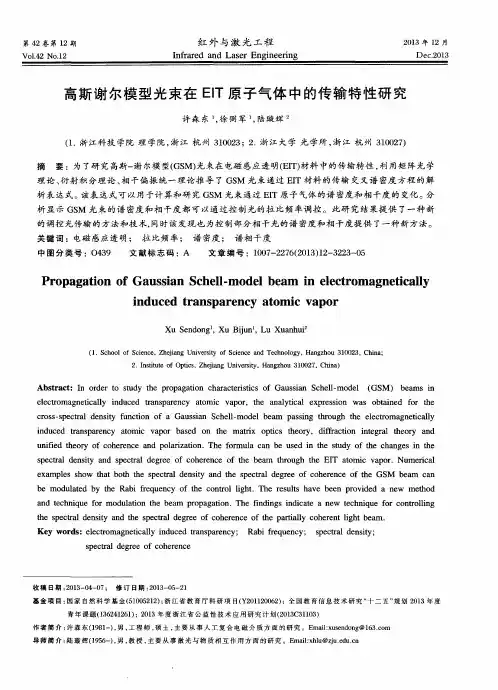
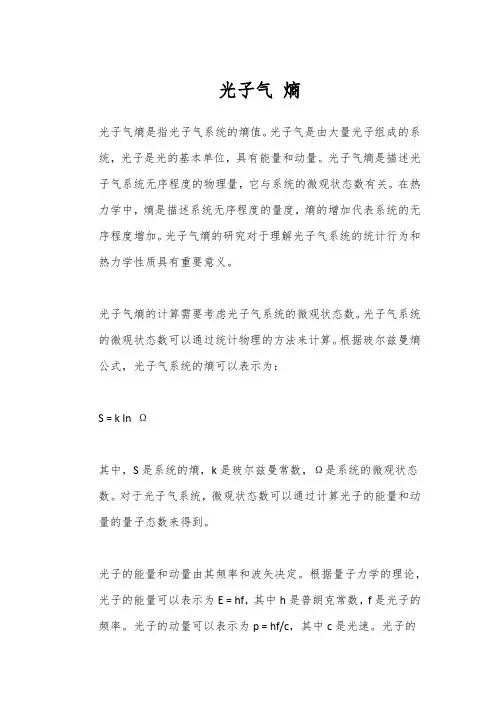
光子气熵光子气熵是指光子气系统的熵值。
光子气是由大量光子组成的系统,光子是光的基本单位,具有能量和动量。
光子气熵是描述光子气系统无序程度的物理量,它与系统的微观状态数有关。
在热力学中,熵是描述系统无序程度的量度,熵的增加代表系统的无序程度增加。
光子气熵的研究对于理解光子气系统的统计行为和热力学性质具有重要意义。
光子气熵的计算需要考虑光子气系统的微观状态数。
光子气系统的微观状态数可以通过统计物理的方法来计算。
根据玻尔兹曼熵公式,光子气系统的熵可以表示为:S = k ln Ω其中,S是系统的熵,k是玻尔兹曼常数,Ω是系统的微观状态数。
对于光子气系统,微观状态数可以通过计算光子的能量和动量的量子态数来得到。
光子的能量和动量由其频率和波矢决定。
根据量子力学的理论,光子的能量可以表示为E = hf,其中h是普朗克常数,f是光子的频率。
光子的动量可以表示为p = hf/c,其中c是光速。
光子的能量和动量是量子化的,只能取离散的值。
对于光子气系统,可以将光子的能量和动量量子化为离散的能级。
光子的能级可以表示为En = nhf,其中n是一个非负整数,表示能级的编号。
光子的动量量子化为离散的动量值pn = nhf/c。
根据能量和动量的量子化条件,可以得到光子的能量和动量的量子态数。
光子的能量和动量的量子态数可以通过计算能级和动量值的数量来得到。
对于能级,能级的数量等于能级的最大编号加1,即N = nmax + 1。
对于动量值,动量值的数量等于动量值的最大编号加1,即M = pmax + 1。
光子的能量和动量的量子态数可以表示为Ω= NM。
根据光子的能量和动量的量子态数,可以计算光子气系统的微观状态数。
光子气系统的微观状态数等于能量和动量的量子态数的乘积,即Ω= ΩE ×Ωp。
光子气系统的微观状态数可以表示为Ω= (nmax + 1) ×(pmax + 1)。
将光子气系统的微观状态数代入玻尔兹曼熵公式,可以得到光子气系统的熵。
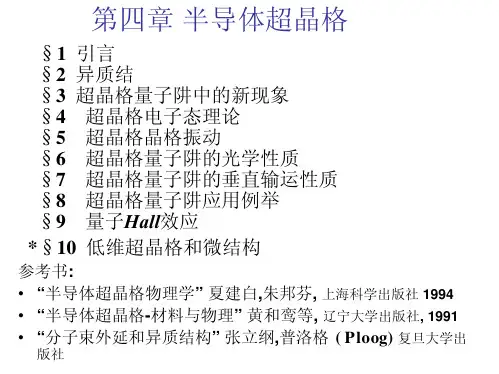
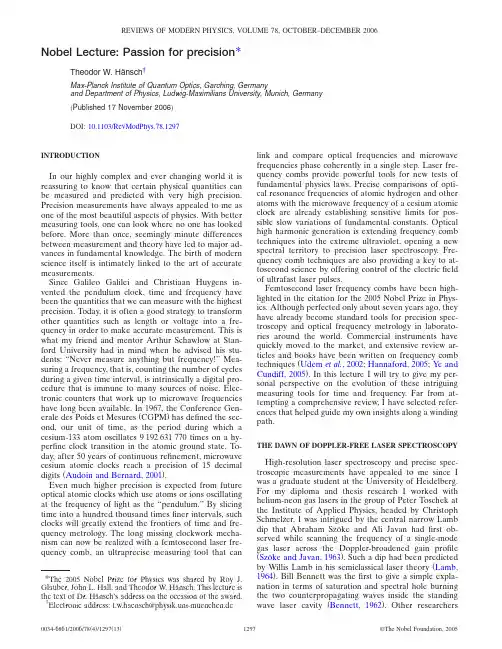
Nobel Lecture:Passion for precision*Theodor W.Hänsch†Max-Planck Institute of Quantum Optics,Garching,Germanyand Department of Physics,Ludwig-Maximilians University,Munich,Germany͑Published17November2006͒DOI:10.1103/RevModPhys.78.1297INTRODUCTIONIn our highly complex and ever changing world it is reassuring to know that certain physical quantities can be measured and predicted with very high precision. Precision measurements have always appealed to me as one of the most beautiful aspects of physics.With better measuring tools,one can look where no one has looked before.More than once,seemingly minute differences between measurement and theory have led to major ad-vances in fundamental knowledge.The birth of modern science itself is intimately linked to the art of accurate measurements.Since Galileo Galilei and Christiaan Huygens in-vented the pendulum clock,time and frequency have been the quantities that we can measure with the highest precision.Today,it is often a good strategy to transform other quantities such as length or voltage into a fre-quency in order to make accurate measurement.This is what my friend and mentor Arthur Schawlow at Stan-ford University had in mind when he advised his stu-dents:“Never measure anything but frequency!”Mea-suring a frequency,that is,counting the number of cycles during a given time interval,is intrinsically a digital pro-cedure that is immune to many sources of noise.Elec-tronic counters that work up to microwave frequencies have long been available.In1967,the Conference Gen-erale des Poids et Mesures͑CGPM͒has defined the sec-ond,our unit of time,as the period during which a cesium-133atom oscillates9192631770times on a hy-perfine clock transition in the atomic ground state.To-day,after50years of continuous refinement,microwave cesium atomic clocks reach a precision of15decimal digits͑Audoin and Bernard,2001͒.Even much higher precision is expected from future optical atomic clocks which use atoms or ions oscillating at the frequency of light as the“pendulum.”By slicing time into a hundred thousand timesfiner intervals,such clocks will greatly extend the frontiers of time and fre-quency metrology.The long missing clockwork mecha-nism can now be realized with a femtosecond laser fre-quency comb,an ultraprecise measuring tool that can link and compare optical frequencies and microwavefrequencies phase coherently in a single ser fre-quency combs provide powerful tools for new tests offundamental physics laws.Precise comparisons of opti-cal resonance frequencies of atomic hydrogen and otheratoms with the microwave frequency of a cesium atomicclock are already establishing sensitive limits for pos-sible slow variations of fundamental constants.Opticalhigh harmonic generation is extending frequency combtechniques into the extreme ultraviolet,opening a newspectral territory to precision laser spectroscopy.Fre-quency comb techniques are also providing a key to at-tosecond science by offering control of the electricfieldof ultrafast laser pulses.Femtosecond laser frequency combs have been high-lighted in the citation for the2005Nobel Prize in Phys-ics.Although perfected only about seven years ago,theyhave already become standard tools for precision spec-troscopy and optical frequency metrology in laborato-ries around the mercial instruments havequickly moved to the market,and extensive review ar-ticles and books have been written on frequency combtechniques͑Udem et al.,2002;Hannaford,2005;Ye andCundiff,2005͒.In this lecture I will try to give my per-sonal perspective on the evolution of these intriguingmeasuring tools for time and frequency.Far from at-tempting a comprehensive review,I have selected refer-ences that helped guide my own insights along a windingpath.THE DAWN OF DOPPLER-FREE LASER SPECTROSCOPY High-resolution laser spectroscopy and precise spec-troscopic measurements have appealed to me since Iwas a graduate student at the University of Heidelberg.For my diploma and thesis research I worked withhelium-neon gas lasers in the group of Peter Toschek atthe Institute of Applied Physics,headed by ChristophSchmelzer.I was intrigued by the central narrow Lambdip that Abraham Szöke and Ali Javan hadfirst ob-served while scanning the frequency of a single-modegas laser across the Doppler-broadened gain profile ͑Szöke and Javan,1963͒.Such a dip had been predicted by Willis Lamb in his semiclassical laser theory͑Lamb,1964͒.Bill Bennett was thefirst to give a simple expla-nation in terms of saturation and spectral hole burningthe two counterpropagating waves inside the standingwave laser cavity͑Bennett,1962͒.Other researchers*The2005Nobel Prize for Physics was shared by Roy J.Glauber,John L.Hall,and Theodor W.Hänsch.This lecture isthe text of Dr.Hänsch’s address on the occasion of the award.†Electronic address:t.w.haensch@physik.uni-muenchen.deREVIEWS OF MODERN PHYSICS,VOLUME78,OCTOBER–DECEMBER20060034-6861/2006/78͑4͒/1297͑13͒©The Nobel Foundation,20051297such as John Hall,Veniamin Chebotaev,or Christian Bordésoon explored“inverted Lamb dips”by placing some absorbing molecular gas inside the laser cavity ͑Letokhov and Chebotaev,1977͒.With resonances ofunprecedented spectral resolution,one could almost smell the revolution in laser spectroscopy that would un-fold within the next few years.At that time,however, such Doppler-free spectroscopy remained limited to the study of gas laser transitions or of a few molecular ab-sorption lines in accidental coincidence.In my own work with Peter Toschek,I studied quantum interference ef-fects in coupled atomic three-level systems͑Hänsch et al.,1969;Hänsch and Toschek,1970͒,demonstrating phenomena that have recently been recognized as im-portant,such as lasing without inversion or electromag-netically induced transparency.They are also essential to understand slow light.In1970,I joined Arthur L.Schawlow at Stanford Uni-versity as a post-doc.Collaborating in separate experi-ments with Peter Smith,then at Berkeley͑Smith and Hänsch,1971͒,and with Marc Levenson at Stanford ͑Hänsch,Levenson,et al.,1971͒,I perfected a new method of Doppler-free saturation spectroscopy that did not require the sample to be placed inside a laser cavity. Soon afterwards,I succeeded in making a nitrogen-laser-pumped widely tunable pulsed dye laser so highly mono-chromatic that we could apply Doppler-free saturation spectroscopy to arbitrarily chosen atomic resonance lines͑Hänsch,Shahin,et al.,1971;Hänsch,1972͒. Broadly tunable laser action in liquid solutions of or-ganic dyes had been discovered in1966independently by Fritz Schäfer͑Schäfer et al.1966͒and Peter Sorokin ͑Sorokin and Lankard,1966͒.LASER SPECTROSCOPY OF ATOMIC HYDROGEN Arthur Schawlow at Stanford suggested to apply our technique to the red Balmer-␣line of atomic hydrogen that had been at the center of attention of atomic spec-troscopists in the1930s because of suspected discrepan-cies between the observed line profile and the predic-tions of Dirac’s relativistic quantum theory͑Series,1957͒In those days,spectroscopists could only observe a blend of unresolvedfine-structure components because Dop-pler broadening is particularly large for the light hydro-gen atoms.Spectroscopy of the simple hydrogen atom has long played a central role in the history of atomic physics.The visible Balmer spectrum was the Rosetta stone that allowed us to decipher the laws of quantum physics.It has inspired the groundbreaking discoveries of Niels Bohr,Arnold Sommerfeld,Louis De Broglie, Erwin Schrödinger,Paul Dirac,and even Willis Lamb at the origin of modern quantum electrodynamics.In1972,graduate student Issa Shahin and I were proud to present to Arthur Schawlow a Doppler-free saturation spectrum of the red hydrogen Balmer-␣line, recorded with our pulsed tunable dye laser͑Hänsch et al.,1972͒.The2S Lamb shift,that is,the splitting be-tween the2S1/2and2P1/2states that should be degener-ate according to the Dirac theory,appeared clearly re-solved in the optical spectrum.This was the beginning ofa long adventure in precision spectroscopy of the simplehydrogen atom,which permits unique confrontationsbetween experiment and theory.This quest continues to-day.It has inspired many advances in spectroscopic tech-niques,including thefirst proposal for laser cooling ofatomic gases͑Hänsch and Schawlow,1975͒,and,mostrecently,the femtosecond laser frequency comb.Figure1illustrates how the accuracy of optical spec-troscopy of atomic hydrogen has advanced over time ͑Karshenboim et al.,2001͒.Classical spectroscopists re-mained limited to about six or seven digits of s precisionby the large Doppler broadening of hydrogen spectrallines.In1971,our group at Stanford overcame this bar-rier by nonlinear spectroscopy with a tunable dye laser.Other groups,notably in New Haven,Oxford,and Paris,soon joined in to improve the accuracy by three ordersof magnitude over the next two decades.Around1990,anew barrier appeared:the limits of optical wavelengthmetrology due to unavoidable geometric wave front er-rors.Progress beyond a few parts in1010has been achieved only because we have learned increasingly well how to measure the frequency of light rather than its wavelength.In2003,the accuracy has reached1.4parts in1014͑Fischer et al.,2004͒.Further progress is becom-ing difficult,because we are again approaching a barrier: the limits of how well we know our unit of time,the FIG.1.͑Color͒The relative accuracy in optical spectroscopy of atomic hydrogen is charted over eight decades.Major bar-riers have been overcome in the early1970s with the advent of Doppler-free laser spectroscopy and in the early1990s with the introduction of optical frequency measurements.The accuracy of such measurement will soon be limited by the performance of cesium atomic clocks.Dramatic future advances are ex-pected from the development of optical atomic clocks.1298Theodor W.Hänsch:Nobel lecture:passion for precision Rev.Mod.Phys.,V ol.78,No.4,October–December2006second.Cesium atomic clocks have been continually re-fined over the past50years͑Audoin and Bernard,2001͒, as shown by the dashed line in Fig.1,but the potential for further improvements seems almost exhausted. However,our optical frequency-counting techniques make it now feasible to develop optical atomic clocks, based on sharp optical resonances in laser-cooled trapped ions,neutral atoms,or molecules.With such clocks future spectroscopic measurements may reach ac-curacies of parts in1018and beyond.In atomic hydrogen,the highest resolution can be achieved on the ultraviolet1S-2S two-photon resonance with a natural linewidth of only1Hz.First-order Dop-pler shifts cancel if this transition is excited with two counterpropagating laser waves,as wasfirst pointed out by Veniamin Chebotaev͑Baklanov and Chebotaev, 1974͒.Thefirst Doppler-free spectra were recorded in, our laboratory at Stanford in1975͑Hänsch et al.,1975͒. At Garching,we observed this resonance by collinear excitation of a cold hydrogen atomic beam͑Fischer et al.,2004͒.Starting in1986,many generations of graduate students and post-docs have made important contribu-tions to advance the state of the art.Today,the hydrogen atoms are produced by micro-wave dissociation of molecules and cooled to a tempera-ture of about6K by collisions with the walls of a nozzle mounted to a helium cryostat.A collinear standing wave field at243nm for Doppler-free two-photon excitation is produced by coupling the frequency-doubled output of a dye laser into a buildup cavity inside the vacuum chamber.Atoms excited to the2S metastable state,after traveling along a path of about10cm,are detected by applying a quenching electricfield and counting the emitted vacuum ultraviolet Lyman-␣photons.The laser light is periodically blocked by a chopper,and the pho-ton counts are sorted into bins corresponding to differ-ent delay times.With slow atoms selected by a delay time of1.3ms,the linewidth is now reduced to about 530Hz at243nm corresponding to a resolution of4.3 parts in1013.We would have to reach an accuracy of5 parts in1015in order to measure the line position to1% of this width.MEASURING OPTICAL FREQUENCIESThe observation of sharp optical resonances by non-linear laser spectroscopy with a resolution much beyond the measurement limits of wavelength interferometry had long created a strong need for methods to measure the frequency rather than the wavelength of light.The quest for an optical frequency counter is almost as old as the laser itself.Ali Javan,the coinventor of the helium-neon laser,was thefirst to superimpose the beams from two different lasers with a beam splitter on a photode-tector to observe a beat note,similar to the interference of the sound waves from two tuning forks͑Javan et al., 1962͒.This was an extraordinary result,because it proved that laser waves can behave like classical radio waves.A coherent laser wave can have a well-defined phase and amplitude,so that it must be possible to count the ripples of such a light wave.However,at a frequency near500000billion oscillations per second,there are no electronic detectors and circuits fast enough to build an optical frequency counter.At MIT in the early1960s,Ali Javan started a re-search project,aimed at extending microwave frequency-counting techniques into the optical spectral region.He experimented with whiskerlike metal-insulator-metal point contacts as antennas,detectors, and mixers for infrared laser waves.Such elements were later used by John Hall and Ken Evenson at NBS͑now NIST͒in Boulder to realize thefirst harmonic laser fre-quency chain,which was used to determine the speed of light by measuring both the wavelength and the fre-quency of a methane-stabilized3.39m helium-neon gas laser͑Evenson et al.,1972͒.Harmonic laser frequency chains were highly complex systems,engineered to mea-sure just one particular optical frequency,and only a handful of these chains have ever been constructed at a number of well-equipped national metrology laborato-ries.In the early1980s,a chain at NBS in Boulder was perfected so that it could measure the frequencies of some iodine-stabilized visible helium-neon lasers to10 decimal digits.This demonstration led the Conference Generate des Poids et Mesures in1983to redefine the meter by defining the speed of light in vacuum c as ex-actly299792458meters per second.One meter is then the distance traveled by light during the time of 1/299792458seconds.From now on,one could deter-mine the precise wavelength of a laser in vacuum,l,by simply measuring the frequency f,since f=c. Unfortunately,the complex NBS frequency chain had to be abandoned soon after this definition was in the books,and for the next decade there was not a single laboratory in the U.S.that could have followed this pre-scription.A number of European laboratories did bet-ter,notably the Observatoire in Paris͑now BNM SYRTE͒and the Physikalisch-Technische Bundesan-stalt͑PTB͒in Braunschweig.In an article published in early1996͑Schnatz et al.,1996͒,a team from the PTB laid claim to thefirst phase-coherent frequency mea-surement of visible radiation.An elaborate frequency chain,filling three large laboratories spread over two separate buildings,was assembled to compare the fre-quency of the red intercombination line of atomic cal-cium with the microwave frequency of a cesium atomic clock.To reach sufficient phase stability,the clock fre-quency wasfirst reduced to the100MHz of a stable quartz oscillator.From here,the chain traversed the en-tire electromagnetic spectrum in discrete steps,always generating some harmonic frequency in a suitable non-linear element and producing enough power for the next step with a phase-locked transfer oscillator.A tricky puzzle had to be solved to reach the desiredfinal fre-quency with the help of several auxiliary oscillators.It was obvious that we could not afford to assemble such a harmonic laser frequency chain for our hydrogen experiments at Garching.As a simpler alternative,I pro-posed a frequency interval divider chain in1988that1299Theodor W.Hänsch:Nobel lecture:passion for precision Rev.Mod.Phys.,V ol.78,No.4,October–December2006worked with frequency differences rather than the fre-quencies themselves so that one could stay in a conve-nient region of the electromagnetic spectrum such as the near-infrared where compact diode laser sources are available͑Hänsch,1989͒.The basic building block is an interval divider stage with a laser that is servo-controlled to oscillate at the precise midpoint of two input frequen-cies.To this end,the second harmonic frequency of the central laser is compared to the sum of the two input frequencies,as generated in a nonlinear optical crystal. With a cascaded chain of n such interval dividers,a large frequency interval can be divided by2n.To measure an absolute laser frequency f,one could start with the in-terval between f and its second harmonic2f,which is just equal to the frequency f.After repeatedly cutting this interval in half with perhaps15stages,the remain-ing frequency gap is small enough that it can be ob-served as a beat note with a fast photodetector and mea-sured with a microwave frequency counter.With HaraldTelle,who had joined us from the PTB,and Dieter Me-schede,we demonstrated thefirst working interval di-vider in1990͑Telle et al.,1990͒.We never assembled a complete optical frequency counter,but we constructed a chain of four interval di-viders to measure a frequency interval of1THz that we encountered when comparing our hydrogen1S-2S fre-quency with the infrared frequency of a methane-stabilized infrared helium-neon laser at3.39mm as the starting point of our own short harmonic laser frequency chain͑Udem et al.,1997͒.This intermediate frequency reference had to be repeatedly shuttled to Braunschweig to be calibrated with the PTB frequency chain against a cesium clock.In1997,we established a new record in optical frequency metrology͑Udem et al.,1997͒by de-termining the ultraviolet1S-2S frequency to within3.7 parts in1013.From this and other spectroscopic mea-surement in hydrogen,we were able to derive a new value of the Rydberg constant,the scaling factor for any spectroscopic transition,and the most precisely known of the fundamental constants.We could also derive the Lamb shift of the1S ground state accurately enough to provide a stringent new test of bound-state quantum electrodynamics.Assuming that QED is correct we could also determine new values for the root-mean-square charge radius of the proton and the structure ra-dius of the deuteron͑Udem et al.,1997;Huber et al., 1998͒.We were rather proud that the accuracy achieved with our table-top experiments exceeded that of elec-tron scattering experiments with large accelerators by an order of magnitude.Soon,a number of metrology laboratories set out to build optical frequency counters based on optical inter-val division.At Garching,we were also experimenting with electro-optic frequency comb generators kindly provided by Motonobu Kourogi,which could produce an evenly spaced comb of modulation sidebands extend-ing over several THz͑Kourogi et al.,1993͒.A frequency counter could have been realized with only six or seven interval divider stages,if thefinal frequency gap was bridged with such an electro-optic comb generator.Dur-ing an extended visit to Garching,Motonobu Kourogi showed us how to observe even feeble comb lines by heterodyne detection,improving the signal-to-noise ra-tio with optical balanced receivers and variable beam splitters.We soon verified the accuracy of this frequency comb generator and our frequency interval divider chain in a direct comparison͑Udem et al.,1998͒.Many other alternatives have been explored in the long quest for precise optical frequency measurements, including interferometry with modulated laser waves ͑Bay et al.,1972;DeVoe et al.,1988͒or frequency divi-sion with phase-locked optical parametric oscillators ͑Wong,1992͒.David Wineland has proposed to synchro-nize the cyclotron motion of a single electron to a laser wave͑Wineland,1979͒.ln the meantime all these ap-proaches have become obsolete.Since1998,optical fre-quency measurements have been enormously simplified with the advent of femtosecond laser optical frequency comb synthesizers͑Fig.2͒͑Udem et al.,2002;Ye and Cundiff,2005͒.FEMTOSECOND LASER OPTICAL FREQUENCY COMBS The scheme of a frequency comb synthesizer is rather simple,as illustrated in Fig.2.At the heart is a single mode-locked femtosecond laser that maintains a soliton-like short pulse circulating inside the optical cavity.This laser can be compared to Einstein’s gedanken light clock.With each round trip,an attenuated copy of the light pulse escapes so that the laser emits a regular train of ultrashort pulses.To measure the unknown frequency of a laser wave,the beam and the pulse train are super-imposed with a beam splitter,and a photodetector reg-isters an interference signal.In the idealized case of a perfectly periodic pulse train,we would expect a low-frequency beat note whenever the laser frequency comes close to a value where an integer number of os-cillationsfits in the time interval between two pulses.To give an example,if we know that the laser emitspre-FIG.2.͑Color͒Scheme of femtosecond laser frequency comb synthesizer.1300Theodor W.Hänsch:Nobel lecture:passion for precision Rev.Mod.Phys.,V ol.78,No.4,October–December2006cisely one billion pulses per second and if we can be sure that the laser wave oscillates precisely500000times dur-ing the pulse repetition period,then we know that the optical frequency must be500000billion cycles per sec-ond.In the frequency domain,we can argue that the coupled longitudinal modes of the pulsed laser form an evenly spaced comb of spectral lines.A low-frequency beat note is expected whenever the unknown laser fre-quency approaches one of these comb lines.The origin of the comb spectrum is well explained by Antony E. Siegman in his classic textbook͑Siegmann,1986͒.Con-sider an arbitrary optical waveform circulating inside an optical cavity.During each round trip,an attenuated copy escapes through a partly transmitting mirror.A single copy will have a broad and more or less compli-cated spectrum.However,two identical copies end to end will produce interference fringes in the spectrum, somewhat reminiscent of Young’s double-slit experi-ment.Three copies produce a spectrum that resembles the interference pattern of a triple slit,and an infinite series of copies produces sharp lines that can be identi-fied with the modes of the cavity.Mathematically,an ideal periodic pulse train can be described in terms of a Fourier series,and the comb lines correspond to the el-ements of this series.The separation between two modes or comb lines is just equal to the repetition frequency f r.This remains true even if the pulses are not identical replicas but if we allow for a͑reproducible͒slip of the phase of the elec-tromagnetic“carrier”wave relative to the pulse enve-lope from pulse to pulse͑Eckstein,1978;Udem et al., 2002;Ye and Cundiff,2005͒.Such phase slips are un-avoidable in a real laser because of dispersion in the cavity.The entire comb will then be shifted relative to the integer harmonics of the repetition frequency f r by a carrier-envelope offset frequency f CE,which equals the net phase slip modulo2per pulse interval.The fre-quency of a comb line with integer mode number m is then given byf m=mf r+f CE.Such a comb acts like a ruler in frequency space that can be used to measure a large separation between two different optical frequencies in terms of the pulse repeti-tion rate f r.If these two frequencies are known multiples or fractions of the same laser frequency f,such a mea-surement reveals the optical frequency f r itself.With a known repetition frequency f r,the beat signal between a known optical frequency f and the nearest comb line reveals the previously unknown offset frequency f CE. The frequency of any comb line can be calculated from the two radio frequencies f r,and f CE together with the integer mode number.It has been surprising to most experts how far this frequency comb approach can be pushed.The frequency spectrum of a femtosecond laser oscillator can be broad-ened in a nonlinear optical medium to span more than an optical octave without destroying the integrity of the comb lines.In a now common implementation,the pulse train from a Kerr-lens mode-locked Ti:sapphire laser is sent through a microstructured silicafiber,with a small solidfiber core surrounded by air-filled holes͑Birks et al.,1995;Ranka et al.,2000͒.The large change in refrac-tive index at the silica-air interface permits guiding by total internal reflection even if the incoming beam is tightly focused to a high intensity.Since part of the light travels as an evanescent wave in air,an additional engi-neering parameter is available in such afiber to reduce the spreading of an injected pulse due to group velocity dispersion.Inside thefiber,the pulse spectrum is broad-ened by self-phase modulation due to the intensity-dependent refractive index,soliton splitting,shock wave formation,and other nonlinear optical processes.The emerging white light can be dispersed with a grating to form a rainbow of colors.However,this is not ordinary white light.Remarkably,the processes generating the white light can be so highly reproducible that successive pulses are still correlated in their phases and can inter-fere in the spectrum to form a comb of several hundred thousand sharp spectral lines.By now,it has been confirmed in many experiments that the line spacing is very precisely equal to the rep-etition frequency f r.With a comb spanning more than an octave,it is particularly simple to measure the carrier-envelope offset frequency f CE.One can simply select a few thousand comb lines from the red end of the spec-trum and send the light pulses through a frequency-doubling crystal,so that new comb lines are generated that are now displaced by twice the offset frequency f CE.A collective beat note with the corresponding original comb lines near the blue end of the spectrum directly reveals the shift f CE.Once this frequency can be mea-sured,it can be controlled,for instance,by adjusting the dispersion in the laser cavity or simply by changing the pump power.One can even set f CE to zero so that the frequencies of the comb lines become precise integer multiples of the laser repetition frequency f r.So far,we have treated all light waves as classical elec-tromagnetic waves.The quantum optical aspects of fre-quency combs,that is,expected correlations in the noise due to photons and their entanglement,have not yet been explored.Such studies may lead to a rich newfield of research.A laser frequency comb provides a direct link be-tween optical frequencies and microwave frequencies. This link can be used in either direction.We can mea-sure or control the repetition frequency f r,with a cesium atomic clock to synthesize several hundred thousand sharp optical reference frequencies which are precisely known in terms of the primary standard of time.Any unknown frequency can then be determined byfirst making a wavelength measurement with a conventional wave meter that is sufficiently accurate to determine the integer order number m of the nearest comb line.The precise distance from this reference line is then mea-sured by feeding a beat signal to a microwave counter. In the reverse direction,we can start with a sharp optical reference line in some cold trapped ion,cold atoms,or1301Theodor W.Hänsch:Nobel lecture:passion for precision Rev.Mod.Phys.,V ol.78,No.4,October–December2006。

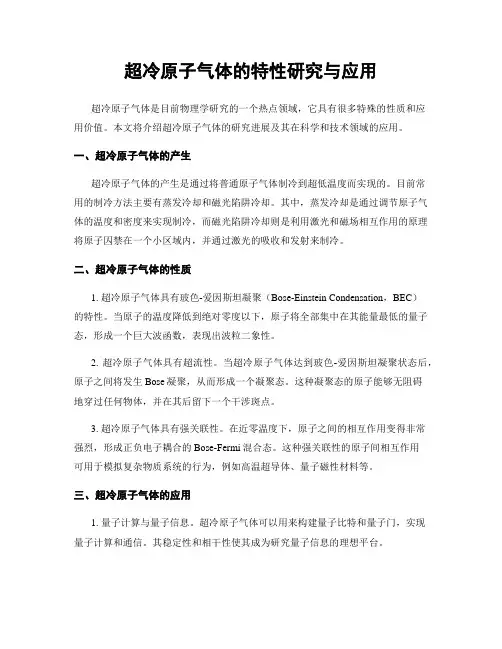
超冷原子气体的特性研究与应用超冷原子气体是目前物理学研究的一个热点领域,它具有很多特殊的性质和应用价值。
本文将介绍超冷原子气体的研究进展及其在科学和技术领域的应用。
一、超冷原子气体的产生超冷原子气体的产生是通过将普通原子气体制冷到超低温度而实现的。
目前常用的制冷方法主要有蒸发冷却和磁光陷阱冷却。
其中,蒸发冷却是通过调节原子气体的温度和密度来实现制冷,而磁光陷阱冷却则是利用激光和磁场相互作用的原理将原子囚禁在一个小区域内,并通过激光的吸收和发射来制冷。
二、超冷原子气体的性质1. 超冷原子气体具有玻色-爱因斯坦凝聚(Bose-Einstein Condensation,BEC)的特性。
当原子的温度降低到绝对零度以下,原子将全部集中在其能量最低的量子态,形成一个巨大波函数,表现出波粒二象性。
2. 超冷原子气体具有超流性。
当超冷原子气体达到玻色-爱因斯坦凝聚状态后,原子之间将发生Bose凝聚,从而形成一个凝聚态。
这种凝聚态的原子能够无阻碍地穿过任何物体,并在其后留下一个干涉斑点。
3. 超冷原子气体具有强关联性。
在近零温度下,原子之间的相互作用变得非常强烈,形成正负电子耦合的Bose-Fermi混合态。
这种强关联性的原子间相互作用可用于模拟复杂物质系统的行为,例如高温超导体、量子磁性材料等。
三、超冷原子气体的应用1. 量子计算与量子信息。
超冷原子气体可以用来构建量子比特和量子门,实现量子计算和通信。
其稳定性和相干性使其成为研究量子信息的理想平台。
2. 凝聚态物理的研究。
超冷原子气体中的玻色-爱因斯坦凝聚状态可以用来研究量子流体、拓扑绝缘体等凝聚态物理现象,帮助人们更深入地理解凝聚态物质的行为。
3. 精密测量和惯性导航。
超冷原子作为高精度的量子测量仪器,可以用于测量时间、磁场、重力等物理量,且具有极高的灵敏度和精度。
此外,超冷原子的超流性质也可以用于惯性导航和惯性传感器的研究。
4. 卡尔曼滤波和惯性约束融合导航。
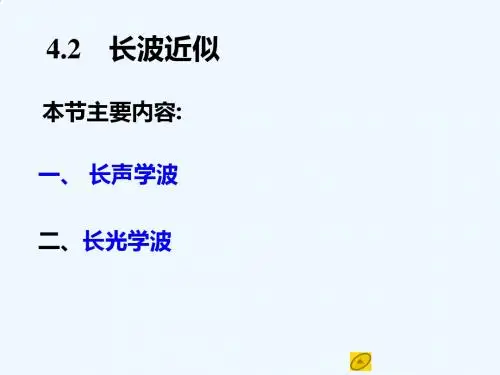

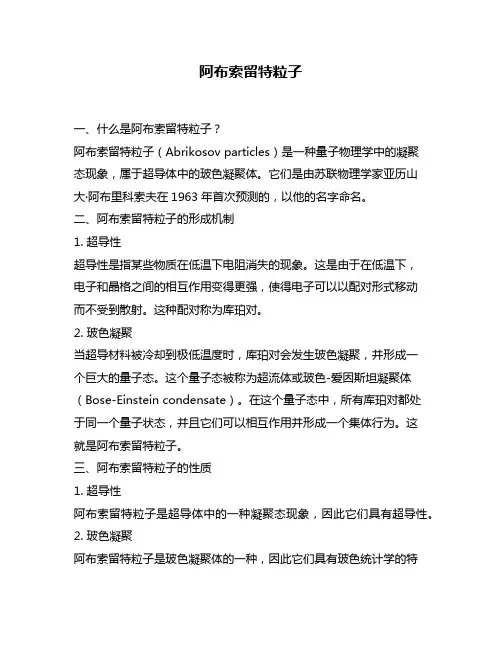
阿布索留特粒子一、什么是阿布索留特粒子?阿布索留特粒子(Abrikosov particles)是一种量子物理学中的凝聚态现象,属于超导体中的玻色凝聚体。
它们是由苏联物理学家亚历山大·阿布里科索夫在1963年首次预测的,以他的名字命名。
二、阿布索留特粒子的形成机制1. 超导性超导性是指某些物质在低温下电阻消失的现象。
这是由于在低温下,电子和晶格之间的相互作用变得更强,使得电子可以以配对形式移动而不受到散射。
这种配对称为库珀对。
2. 玻色凝聚当超导材料被冷却到极低温度时,库珀对会发生玻色凝聚,并形成一个巨大的量子态。
这个量子态被称为超流体或玻色-爱因斯坦凝聚体(Bose-Einstein condensate)。
在这个量子态中,所有库珀对都处于同一个量子状态,并且它们可以相互作用并形成一个集体行为。
这就是阿布索留特粒子。
三、阿布索留特粒子的性质1. 超导性阿布索留特粒子是超导体中的一种凝聚态现象,因此它们具有超导性。
2. 玻色凝聚阿布索留特粒子是玻色凝聚体的一种,因此它们具有玻色统计学的特征。
3. 长程相干性由于所有的库珀对都处于同一个量子状态中,阿布索留特粒子具有长程相干性。
这意味着它们可以在材料中传播而不遭受散射。
4. 巨磁效应阿布索留特粒子与磁场之间存在相互作用,因此它们具有巨磁效应。
这意味着当一个磁场施加到超导体上时,阿布索留特粒子会在其中形成一个巨大的磁场。
四、应用领域1. 纳米电子学由于阿布索留特粒子具有长程相干性和巨磁效应,它们被广泛用于纳米电子学中。
在纳米电路中使用超导材料可以提高电路速度和稳定性。
2. 超导磁体阿布索留特粒子的巨磁效应使得它们非常适合用于超导磁体中。
在MRI机中使用超导磁体可以提高成像质量和分辨率。
3. 超导电缆由于阿布索留特粒子具有超导性,它们被广泛用于制造超导电缆。
这些电缆可以传输更大的电流而不会产生能量损失。
五、总结阿布索留特粒子是一种量子物理学中的凝聚态现象,它们是由超导材料中的库珀对形成的玻色凝聚体。
arXiv:cond-mat/0508134v2 [cond-mat.supr-con] 7 Nov 2005Superfluidityofp-waveands-waveatomicFermigasesinopticallatticesM.IskinandC.A.R.S´adeMeloSchoolofPhysics,GeorgiaInstituteofTechnology,Atlanta,Georgia30332,USA(Dated:February2,2008)
Weconsiderp-wavepairingofsinglehyperfinestateands-wavepairingoftwohyperfinestatesultracoldatomicgasestrappedinquasi-two-dimensionalopticallattices.First,weanalysesuperfluidpropertiesofp-waveands-wavesymmetriesinthestrictlyweakcouplingBCSregimewherewediscusstheorderparameter,chemicalpotential,criticaltemperature,atomiccompressibilityandsuperfluiddensityasafunctionoffillingfactorfortetragonalandorthorhombicopticallattices.Second,weanalysesuperfluidpropertiesofp-waveands-wavesuperfluidsintheevolutionfromBCStoBECregimeatlowtemperatures(T≈0),wherewediscussthechangesinthequasi-particleexcitationspectrum,chemicalpotential,atomiccompressibility,Cooperpairsizeandmomentumdistributionasafunctionoffillingfactorandinteractionstrengthfortetragonalandorthorhombicopticallattices.
PACSnumbers:74.25.Bt,74.25.Dw,03.75.Ss,03.75.Hh
I.INTRODUCTIONTunableopticallatticeshavebeenextensivelyusedtostudyphasetransitionsinbosonicatomicgases1,2,sincetheyallowthecontrolledmanipulationoftheparticledensityn,andoftheratiobetweentheparticletrans-ferenergyt,andtheinterparticleinteractionstrengthV3,4.Thiskindofcontrolisnotfullypresentinstandardfermioniccondensedmattersystems,andhashinderedthedevelopmentofexperimentsthatcouldprobesys-tematicallytheeffectsofstrongcorrelationsasafunctionofnandt/V.However,fermionicatomicgaseslike6Liand40Khavebeensuccesfullytrapped,andtheirnormalstateandsuperfluidpropertiesarebeginningtobestud-ied5,6,7,8,9.Becauseofthegreatertunabilityofexperi-mentalparameters,novelsuperfluidphasesmaybemoreeasilyaccessibleintheexperimentsinvolvingultracoldatomicgases.Forinstance,singlehyperfinestate(SHS)ultracoldatomicsystemsareidealcandidatesfortheob-servationofnoveltripletsuperfluidphasesandfortestingtheoreticalmodelsthatwereproposedearlier.Thus,itisonlynaturaltoproposethatopticallatticescouldbeusedtostudythenormalstateandsuperfluidpropertiesofultracoldfermionicsystemsasafunctionofn,t/Vandlatticesymmetry.Thesesystemsareofbroadinter-estnotonlyfortheatomicphysicscommunitybutalsoforthenuclear,condensedmatterandmoregenerallyforthemany-bodyphysicscommunities,wheremodelsforsuperfluidityhavebeeninvestigatedinvariouscontexts.Theinteractionbetweeninduceddipolemomentsofatomsandtheelectricfieldoflaserbeamsisusedtotrapatoms,particularlyalkaliatoms,inopticallattices.Al-kaliatomshaveonlyoneelectron(S=1/2)outofclosedshells.Thiselectronisinazeroorbitalangularmomen-tum(L=0)channel,anditstotalangularmomentumJ=L+SgivesJ=1/2.Thenuclearangularmo-mentumIandelectronangularmomentumJarecom-binedinahyperfinestatewithtotalangularmomentumF=I+JwhichgivesF=I±1/2foralkalis.Fur-thermore,theelectronandnuclearspinsarecoupledby
thehyperfineinteractionthatsplitstheatomiclevelsintheabsenseofmagneticfieldHhf∝I·J.Aweakmag-neticfieldcausesZeemansplittingofthehyperfinelevels|F,mF>withdifferentmF,whichcanbemadetocorre-spondtopseudo-spinlabels.Trappingone11,12,13,14,15,16,two17,18,19,20,three21andfour22hyperfinestateswereconsideredbyseveralauthors.However,itisalsoknownthattrappingmorehyperfinestatesincreasesthenum-berofchannelsthroughwhichthegascandecay.There-fore,trappingoneortwohyperfinestatesofultracoldfermionicgasesisexperimentallymoreplausible.
Forpairedidenticalfermions,thePauliexclusionprin-ciplerequiresthetotalpairwavefunctiontobeanti-symmetric.Thetotalorbitalangularmomentumshouldbeoddforpseudo-spinsymmetricpairsandevenforpseudo-spinanti-symmetricones.Thereforeinthecaseoftrappingtwohyperfinestates(THS),s-wavescatter-ingofatomsbetweenfermionsfromdifferenthyperfinestatesisdominant.Thus,oneexpectsthatthesuper-fluidgroundstateofsuchtwo-componentFermigasestobes-waveandpseudo-spinsinglet.Presentlythereisexperimentalevidencethat40K(Ref.23,24)and6Li(Ref.25,26,27,28,29)canformweaklyandtightlyboundatompairs,whenthemagneticfieldissweptthroughans-waveFeshbachresonance.
However,thepropertiesofSHSultracoldfermionsandtheirpossiblesuperfluidbehaviourarebeginningtobeinvestigated30,31,32,33,34.Thesesystemsareprobablythenextfrontierforexperimentswithultracoldatoms.Whenidenticalfermionicatomsaretrappedinasinglehyperfinestate,theinteractionbetweenthemisstronglyinfluencedbythePauliexclusionprinciple,whichpro-hibitss-wavescatteringofatomsinidenticalpseudo-spinstates.Asaresult,inSHSdegenerateFermigases,twofermionscaninteractwitheachotheratbestviap-wavescattering.Thus,oneexpectsthatthesuperfluidgroundstateofsuchSHSFermigasestobep-waveandpseudo-spintriplet.